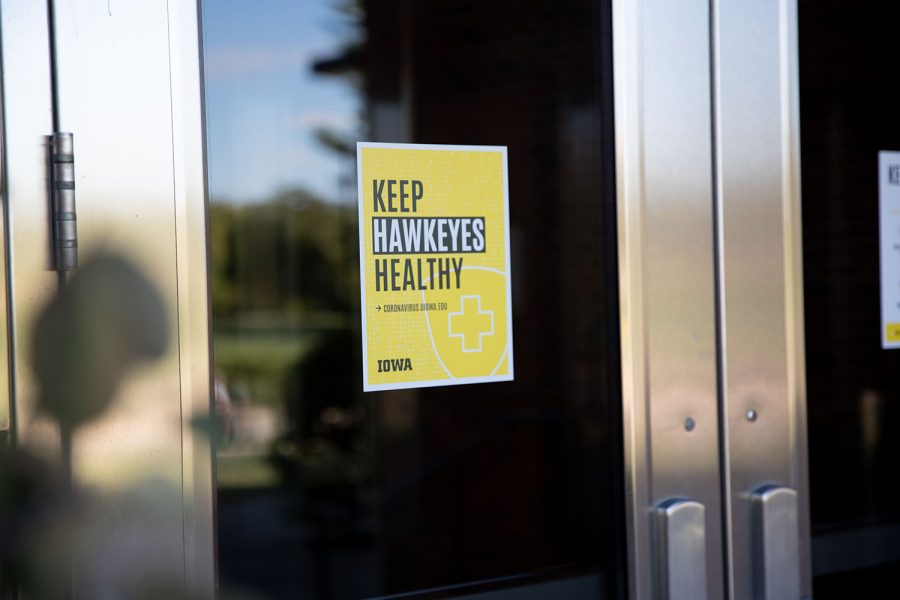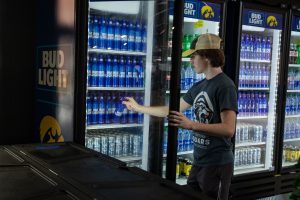COVID-19 cases higher in Johnson County than a year ago
In Iowa City, there are 50 to 60 new cases of the virus each day, making COVID-19 cases higher in the county than a year ago.
A COVID-19 safety sign hangs on the door of the Adler Journalism Building in Iowa City on Thursday, Sept. 23, 2021.
September 26, 2021
Johnson County has seen an average of 400 positive COVID-19 cases every week in the last few weeks.
Since the beginning of September, the state has reported an average of 50 to 60 new cases of COVID-19 a day in the county.
According to a campus email on Sept. 23, Johnson County has reported a seven-day rolling average of 50 cases, as of Sept. 21.
“Thankfully, our collective collaboration and commitment are working to keep our COVID situation stable,” University of Iowa President Barbara Wilson said in a statement on Sept. 23. “To keep our campus experience on track, our best lines of defense against the virus remain: we all need to be vaccinated and to mask up in the classroom and during office hours.”
COVID-19 cases are worse in the county than they were at this time last year: Johnson County reported 301 positive cases during the week of Sept. 20 in 2020, and the county reported that there were 400 positive cases the same week this year.
Johnson County continues to be the most vaccinated county in the state of Iowa, with 74 percent of the county being vaccinated, according to the Centers for Disease Control and Prevention.
Johnson County Public Health Community Health Manager Sam Jarvis said in an update to the Iowa City City Council on Sept. 21 that cases had increased from 30 to 40 cases a day to 50 to 60 cases a day since he last updated the council in the summer.
He said the public health department is continuing to emphasize the importance of vaccination. He said the department is focusing its outreach on people in the “movable middle,” or unvaccinated people that may need more information before deciding to get vaccinated.
“There are some that we probably will not be able to reach and certainly will choose not to get vaccinated, unfortunately,” Jarvis said during the Sept. 21 city council meeting.
In mid-August, Mayor Bruce Teague issued a face-covering order in public spaces to slow the spread of the delta variant. The mandate made mask-wearing mandatory in grocery stores, houses of worship, public school buildings, and government buildings.
On campus, the UI reported seven cases as a seven-day rolling average as of Sept. 21. This number is lower than numbers seen the week of Sept. 13 and in 2020.
Suresh Gunasekaran, CEO of UI Hospitals and Clinics and associate vice president of UI Health Care, said in a Sept. 22 press conference that nearly all intensive care unit patients hospitalized with the virus were unvaccinated.
“The last time that I got an update on this specific topic was two days ago, and on that day, 100 percent of the people were non vaccinated that were in our ICU,” he said. “It’s fluctuated, it’s been 80, it’s been 60, but mostly it’s been the vast majority that have been unvaccinated.”
Gunasekaran said the hospital is experiencing the same staff shortages that hospitals across the country are facing as staff are exiting the field early.
“We’ve had numerous health care workers across the nation exit the healthcare workforce either through early retirement, or just wanting to temporarily take a break, and that’s coming to roost inside of Iowa and inside of UIHC as well,” he said.
Gunasekaran said that these issues are creating capacity challenges, but they are not yet comparable to the challenges faced this time last year.
UIHC has a bed capacity of close to 900.
“I do think that there are capacity challenges being created by these staffing issues, but if I had to put it in perspective, I would say that the bed crunch we saw in Iowa last year was much tighter than it is right now,” he said. “In reality, it was much harder to get beds for COVID patients last year than it is this year.”
Gunasekaran said most COVID-19 patients at UIHC are in-state patients, and his team is remaining very strict on the number of out-of-state patients admitted for care in the hospital.
“We made a decision about 30-60 days ago, given the demands that we were getting from in-state that we were going to be very restrictive to out-of-state transfers,” he said. “So, at UIHC, the number is going to be pretty close to 100 percent in-state for both COVID and non-COVID patients.”
Gunasekaran said that these capacity challenges will only intensify in the winter months if cases continue to increase, especially for non-COVID-19 patients.
“Coming into our second winter, I think that patients who have non-COVID care needs are being affected through delays and waiting and those kinds of things,” he said. “You’re going to see more of that going into the winter if we don’t see a reduction in the COVID activity.”






